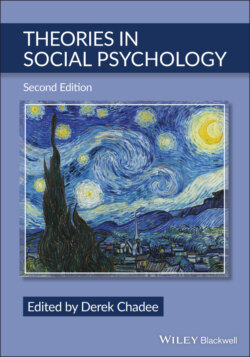Читать книгу Theories in Social Psychology - Группа авторов - Страница 20
Application of Reactance
ОглавлениеThe application of the theory of psychological reactance has been diverse, from its use in the clinical setting to the understanding of social problems, consumer behavior, and power relationships. Rosenberg and Siegel (2018) categorize the contributions of reactance theory into what they referred to as five overlapping waves. These are: Wave 1: Theory proposal and testing; Wave 2: Contributions from clinical psychology; Wave 3: Contributions from communication research; Wave 4: Measurement of reactance; and Wave 5: Return to motivation. Specifically, the theory of psychological reactance has been applied within psychology and other fields and has provided useful insights in areas such as persuasion and resistance to persuasion, attitude change, pro-social behavior, group attractiveness, family interaction, effects of warning labels, littering, promotional influence, manipulative advertisements, product availability, government regulations as threats to freedom, internet and website interaction, health communication, clinical interaction/counseling and reactant personality, family therapy, political behavior, jury behavior, learned helplessness, dispute resolution, and responses to COVID-19.
Some studies on littering (e.g., Brasted et al., 1979) utilized a reactance theory model to understand the relationship between antilittering advertisements and compliance. Messages that were strongly stated and suggested threats to freedom aroused psychological reactance and attempts to restore freedom. Consumers are influenced by promotional campaigns, but the hard-sell advertisements have less of an impact than the soft-sell (low-threat) ones (Regan & Brehm, 1972).
A multitude of studies was undertaken in the area of reactance, attitude change and persuasion, including Worchel and Brehm’ (1970) study on freedom-threatening communication and attitudinal position; Miller (1976) on persuasive messages and attitude change; Carver (1977) on self-awareness, coercion, and persuasion; and Baer et al. (1980) on self-presentation and public attitudes. Wright and Palmer (2012) note that the use of persuasive techniques on the public to portray specific behavioral patterns elicit reactance tendencies. Reactance that invoke the inoculation effect results in reduced attitude change (Miller et al., 2013). Studies by Bushman (1998, 2006) and Clee and Wicklund (1980) are just a few of the many studies that emphasize the impact of message insensitivity– sensitivity on persuasion and compliance. Reinhart and Anker (2012) utilize reactance and transport theory to understand perceptions of persuasive public service announcements on organ donation (see also Scott & Quick, 2012 ; Sukalla et al., 2017). Baumeister et al. (2002) assess the relationship among narcissism, reactance, and sexual concern, arguing that a man with high sexual expectancy of sexual interaction would experience psychological reactance when there is refusal of sexual contact by a woman. The narcissistic inclination may mediate reactance, motivating the individual to attempt sexual coercion and rape. Family socialization impacts freedom sensitivity, which in turn makes the individual more responsive to freedom threats. In particular, persons with an achievement orientation, high independence, and high moral–religious values were positively associated with psychological reactance (Buboltz et al., 2003).
The application of reactance in understanding virtual interaction on the internet was undertaken by Daily (2004). Restrictions and blocks to navigation on the internet create psychological reactance and lead to negative emotions and avoidance behavior toward the blocked websites. Another study assessed forced exposure via pop-up advertisements and psychological reactance, attempting to understand factors that contribute to negative reactions to information and particularly advertisements via the internet (Edwards et al., 2002).
